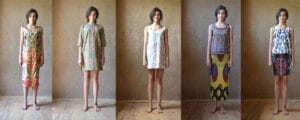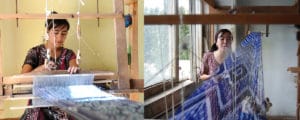
TWO DESIGNERS WHO HAVE NEVER MET CREATE A COLLECTION THAT BRIDGES UZBEK TRADITION AND AMERICAN FASHION
By: Keith Recker
Read original article here.
AND/EYE’s Design Council pairs promising artisan businesses with volunteer professional designers. One such pairing brought Uzbek fashion designer and founder of the Bibi Hanum company, Muhayo Aliyeva, together with Dena Harris, a deeply experienced US merchandising executive and product developer. The result? A gorgeous collection of women’s clothing that uses traditional Uzbek ikat fabrics in simple, contemporary silhouettes. A surprising detail: the team behind the designs created the collection without a single face to face meeting.
The new collection will debut (and Muhayo and Dena will meet) in the Artisan Resource section of NY Now in August 2014. HAND/EYE’s editor Keith Recker recently interviewed Muhayo and Dena.
HAND/EYE: Muhayo, please tell us about your company, Bibi Hanum.
Bibi Hanum is a socially responsible enterprise which creates garments and accessories using traditional hand-woven Uzbek textiles. Its mission is to support local women while preserving our cultural heritage. Bibi Hanum started in 2007 as an atelier in Tashkent, the capital of Uzbekistan, out of my passion for creating clothes and my love for our beautiful, locally produced textiles. There are ten people working in the workshop now, and more women working from home.

HAND/EYE: Dena, when you first saw Bibi Hanum’s collections, what did you see that interested you enough to say YES to a volunteer design partnership?
When I saw Bibi Hanum’s ikat textiles, it was love at first sight. In my long career sourcing and developing home decor products, textiles were always my favorite items. The quality, beauty, and intricacy of Bibi Hanum’s weaving made me want to develop a collection for the US market.
HAND/EYE: Muhayo, when you talked to Dena, did she ask any questions that surprised you?
I was surprised when she asked if I was willing to have her help me create a collection that could be promoted at the high end of the U.S. market. I answered, “Do I agree? Do I agree? Of course! I am all yours.” Even though I had not met her in person, and still haven’t, I feel very connected to her. I felt lucky to have an experienced professional designer from the U.S. assist me with my collection. I needed Dena, but I did not know how to find her and HAND/EYE helped us with that. Thank you!!!
HAND/EYE: You two made a wonderful collection together. Tell us about it.
Dena: I felt that the focus of the collection needed to be the fabric. That inspired me to suggest very simple, minimal garments that would highlight the textiles. The contrast of “ethnic” textiles with contemporary styles, creates a very modern look. Fortunately, this look is very on trend.
Working with Muhayo has been amazing. I would email photos and design concepts, and the next day, a sketch would be in my inbox. A few days later, I’d get a photo of a sample. Considering that we have not yet met in person, we have been very much in sync, with little need for revisions. The fact that we communicate constantly really moves the project along.

Muhayo: When Dena and I first spoke, I said that I would do anything she suggested. In terms of design, I have always thought that more is better: more details, more fabrics, more trim. But Dena’s vision is showing me that often less is better. I am also learning that creating simple things is more difficult than I thought it would be. For example, with this collection, it is important to pair textile colors precisely. This area was always my weakness, especially with all the colors to choose from in the world of ikat. I want to use them all! Dena helped me edit the colors based on swatches I sent to her. I love what we’ve done, and I cannot wait to create more.
HAND/EYE: Muhayo, please tell us how important ikat is to the Uzbek textile tradition, and how you’ve adapted it to the US market.
Central Asian ikat is a tradition of tie-dyed, loom-woven warps that goes back many centuries. In the 20th century, however, because of government policies, it was in danger of being forgotten. Since Uzbekistan’s independence in the early 90s, ikat has been revived in a very important way as a positive symbol of our identity.
Ikat weaving is the intricate process that has approximately 37 steps – from producing silk to the tying of the patterns and multiple dye baths, to hand weaving beautiful meters of ikat on the loom.
For me it is important that our products are made of traditional textiles since it supports women, and the economy of Uzbekistan. It is delightful to hear that many businesses in the U.S. are giving more recognition to the artisan sector, thus providing better opportunities for artists to sell their crafts.

HAND/EYE: Dena, Why do you think US customers will like the collection?
As a buyer and merchant, I have always said that my favorite companies to work for were those where I was the ideal customer. This is a collection for me and those like me (we are legion!) who love exquisite fabrics, but don’t want to wear costumes. This collection is sister to Dosa and Matta, well-made, sophisticated, simple styles that customers can personalize with their own aesthetic. Each piece can easily mix with existing wardrobe items. I see this collection in unique specialty stores around the country.
Bibi Hanum will debut its new collection at Artisan Resource at NY Now, August 16-19 at NYC’s Pier 94. For more information on registering and attending, please see www.artisanresourceny.com.




